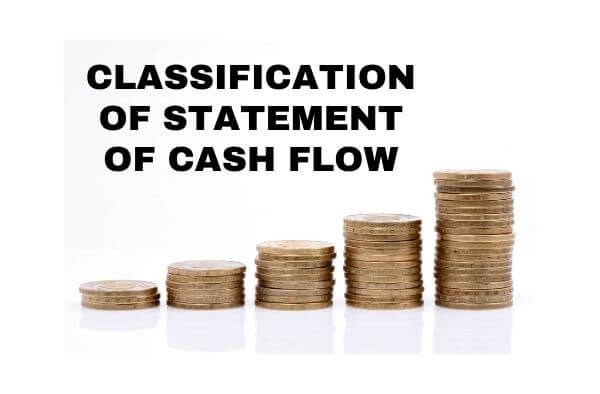Cash Flow Statement | Format | Formula | Template | IAS 7
Cash Flow Statement IAS-7 is mandatory to report as per the international accounting standard (IAS) 1 every company is required to present the financial reports at the end of the financial year. It shows the report of cash inflow and outflow from the organization. Before explaining the topic I would like to explain each word
- Cash is a monetary term, Cash equivalent Refer to the coins, currency, Prize bond, Marketable securities. Or most liquid things like bank balance i.e. check and foreign currency.
- The flow here refers to the change from one place to another of cash; here in accounting, we can say monetary transaction. It may be the inflow or outflow of the organization.
- Statements refer to the standard format of recording the cash movement.
What is a Cash Flow Statement
The cash flow statements provide information about the movement of money into a business. Such as cash receipts (inflow of cash) payment (outflow of cash) in the accounting year. Flows of cash check by the different period of time. Cash flow represents the flow of statement period to period. It provide information regarding the liquidity of the firm. Its explain the reasons for the increase or the decrease in the cash balance from one balance sheet date to the next classifies the reasons for the change as operating, investing and financing activities.
The international accounting standard 7 (IAS 7) is purely designed for cash flow statements. It is also known as the statement of Cash flow.
The Difference between the Income statement and the Cash flow statement is accrual accounting. An income statement shows the items related to the financial period but cash flow represents cash basis transaction irrespective the effect of what financial accounting period.
Cash Inflow and Out Flow
| Operating activities | Investing activities | Financing activities |
|
|
|
What is the Purpose of Cash Flow Statements?
Here the purpose of it is to bind the companies to present the statement in prescribed standard cash flow statement format. So user or stakeholder comes to know about companies activities. Here it’s up to the user what he gets and observes. The main objectives are as mentioned below
- To enable the user to analyze the change in net assets of the company.
- Nature of the company and its focus on what types of activities.
- Management skills are observed, how they generate liquid current asset for operating the business.
- Finding how much cash is generated or used from different types of activities.
- Liquidity of organization for meeting the expense or loan etc. and ability to meet the uncertainty.
- Provide information about cash inflow and out flow during the period
- Provide information about cash changes between two balance sheet data
- Discloses items that effect the balance sheet but do not show up in the income statement
- Categories changes as operating, investing or financing activities
- Highlight cash flow from different activities
- Short term planning
- Cash flow information helps to understand business liquidity position
- Efficient cash management
- Prediction of cash sickness
- Comparison with budget
- Accounting Rules
- Current cash position
Basically, it’s one of the best financial analytic tools to observe the financial position of the company. It helps and update the lender to know the worth of paying back the loan. Employees need to know the WPPF and for shareholders to know profit and dividend importance.
Just like law and order are made in every country for regulating the nation and operations for peace and balance in society. Everyone knows their limits and scope for working. Same here companies and stakeholders are
Methods of Calculating CFS
- Direct Method: Summary of Cash Register Receipts and payments to each head of the account of operating activities. Here simple show the items instead of adjusting items from accrual basis to cash basis.
- Indirect Method: In this need, some changes and adjustment are presented, starting from net profit and then adjust the non-cash items.

Classification of Statement of Cash Flow:
The cash flow statement extracted the amount of net income in a period is usually different than the amount of increase in cash in the same period. The cash flow statement discloses the additional information related to the significant non-cash investing and financing activities and also show a record of cash paid for interest and taxes. The circulation of cash within the business is determined through various below activities.
- Operating Activities
- Investing Activities
- Financial Activities

Operating Activities in Cash Flow Statement
This section relates to the profit and loss account items. The activities are those which are purely revenue-producing activities of the organization. Examples are as mentioned below
- Cash Received against the sale of goods, products
- Cash received in charge of providing services
- Commission, Fees, royalties’ derived cash to the organization.
- Cash paid to the supplies against the purchase of goods and services
- Cash paid to Employees, Salaries, and Wages, etc.
- Cash paid to dealers for the contract of trading activities
Investing Activities of Cash Flow Statement
This section related to the long term assets of the organization. Get the data from the balance sheet. This section is important for investors, which helps in decision making. These are capital nature expenditures. Examples are as mentioned below
- Cash payments for the purchase of fixed assets, like plant and machinery, equipment’s
- Cash Received on the sale of long term assets. Like land and building, plant and machinery.
- Purchasing investment, shares, bonds, Stock
Financing Activities of Cash Flow Statement
As the name indicates Cash activities related to the financing the matter come in this part of the statements. Like payment of a refund of loan, those items which are directly affected on capital and liabilities of the organization are involved in this disclosure.




